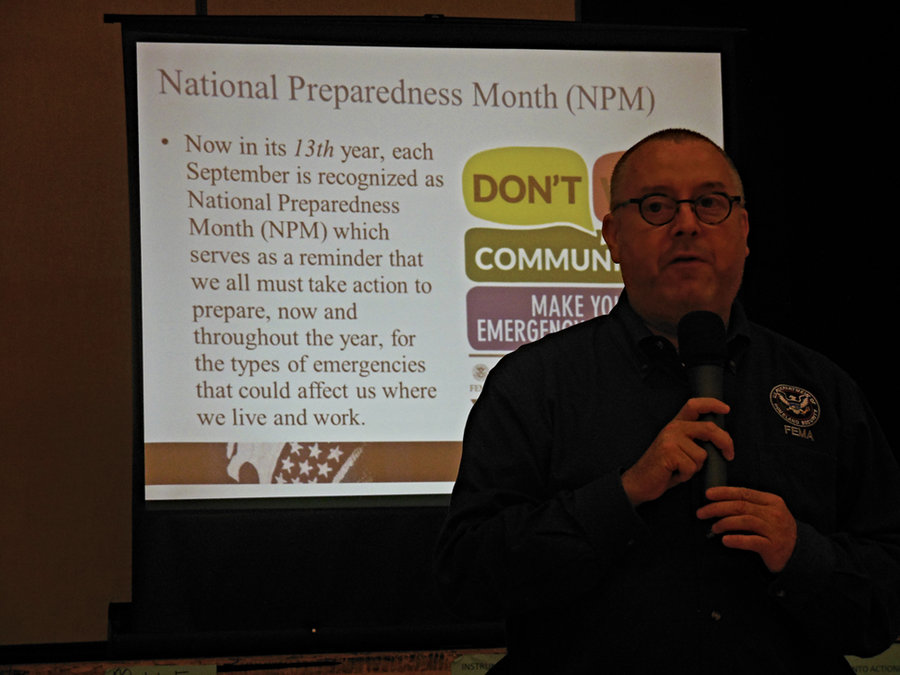A handful of residents attended two workshops on Tuesday, Sept. 20 at the Wallace Elementary School gymnasium to hear representatives from the Federal Emergency Management Agency (FEMA) and The Hoboken Community Emergency Response Team (CERT) educate the public on disaster readiness as part of National Preparedness Month.
Both FEMA and CERT provided the residents with lists of items one should have in an easily accessible “go bag” in case of emergencies. Items on the lists included one gallon of water per person per day for drinking and sanitation, at least a three day supply of non-perishable food, a battery-operated radio, a flashlight, a lantern, extra batteries, a first aid kit, a whistle, a can opener, and a sleeping bag or Mylar blanket.
When in New Jersey…
Russell Fox, branch chief of analysis and integration for Region II of FEMA, said although September is National Preparedness Month, floods aren’t the only form of disaster that New Jersey residents need to worry about. He included wildfires, earthquakes, nor’easters, tornados, oil spills, landslides, power outages, train derailments, and terrorist attacks.
“We prepare folks for an all-hazard view of disasters,” Fox said. “So we want you prepared for anything and everything that could happen.”
Fox stressed the importance of having a “go” kit handy at a moment’s notice, since flooding – a chronic problem in Hoboken – can arise at the snap of a finger.
“What will be the trigger that tells you to leave?” – Russell Fox
____________
Fox pointed to the FEMA app as a way for people to stay informed. It gives updates from the National Weather Service through notifications and issues safety reminders and tips.
According to Fox, family communication plans have become more important because smart phones lull people into thinking they “don’t need to remember numbers anymore.”
He urged the attendees to have a plan in place in case their phone is lost, damaged, destroyed, or unable to charge during a power outage.
He also explained that families and individuals need to establish plans for not only how to evacuate but when to evacuate.
“What will be the trigger that tells you to leave?” Fox asked. “That needs to be established ahead of time.”
He recommended having two places for families to meet in case of separation: “One right outside the home in case of a sudden emergency and another outside of your immediate neighborhood in case you can’t get home.”
Possible disaster exercises
Fox ended the information workshop with a preparedness exercise in which he separated attendees into small groups and gave them a scenario with prompt questions to help individuals become better prepared.
The scenario focused on the possibility of a flood from “the Storm of the Century” and asked residents if they knew the difference between a hurricane watch and a warning, how they could reduce the impact of flooding to their house, which supplies they should have on hand, whether they knew an evacuation route, and where to keep copies of their important documents. (A hurricane watch means conditions are right for a hurricane to occur while a warning means one has already developed.)
Residents recommended sandbags for flooding, keeping documents in the “go” kit in a waterproof Ziploc bag, and having canned food and bottled water on hand.
Melissa Abernathy, a Hoboken resident and Sandy survivor, said that the workshop made her realize she was a “natural doomsday prepper.” She said she “feels less stressed when she is prepared” and had already done most of the recommended suggestions during Superstorm Sandy.
Hoboken resident Chris Stanon said he believed the workshop to be “enlightening and effective” as it helped him realize he was only about “half prepared for a disaster.”
The next meeting, the Hoboken Resilient Buildings Workshop, will take place Oct. 25 from 6:30 p.m. to 8:30 p.m. at the Wallace School gymnasium, 1100 Willow Ave.
According to the city, the Hoboken Resilient Buildings workshop will provide information on how property owners can protect buildings from flood damage and lower their flood insurance rates. The workshop will feature an open house with vendors of resilient building products and services. If available, property owners are encouraged to bring a copy of their elevation certificate and/or flood insurance policy to the workshop.
Attendees are asked to register at www.hobokennj.gov/workshop.
The recent workshop came on the heels of a recent announcement by the federal government and the city of Hoboken that the “Rebuild by Design” team has chosen the third of three design alternatives for flood barriers to protect Hoboken, Weehawken, and Jersey City from storm surges like Hurricane Sandy. This alternative calls for construction of a “flood resistance structure” beginning at the Lincoln Harbor light rail station in Weehawken and following the rail track south, down along Weehawken Cove and into Harborside Park. It then turns east up the alleyway located between 14th and 15th streets and turns south on Washington Street for about one block.
The southern end of the structure has two options still to be decided, either running west along Observer Highway or West through the New Jersey Transit rail yard.
Marilyn Baer can be reached at marilynb@hudsonreporter.com
.
